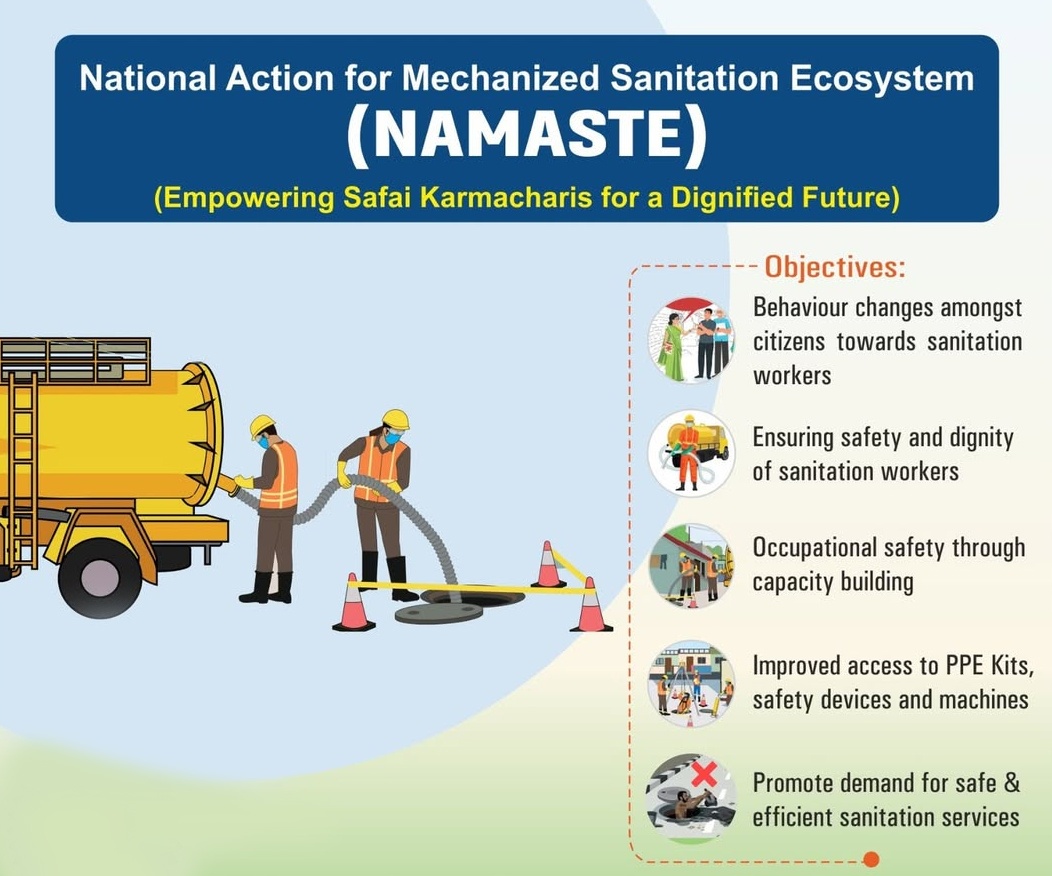Introduction:
Despite several policy efforts and official declarations about the end of manual scavenging in India, hazardous sewer and septic tank cleaning continues to claim lives. A recent social audit commissioned by the Union Government has brought to light glaring gaps in safety, accountability, and rehabilitation for sanitation workers. The findings, made public in the Lok Sabha in July 2025, offer a sobering account of the persistent risks faced by these workers and the limited effectiveness of existing policies.
- According to government data, 150 workers died due to hazardous cleaning of sewers and septic tanks in 2022 and 2023. A broader figure reveals that 1,035 people have died since 1993 due to such activities. A total of 377 deaths occurred between 2019 and 2023 alone, indicating that the problem remains widespread and unresolved.
Findings from the Social Audit:
In September 2023, the Ministry of Social Justice commissioned a study to examine hazardous cleaning deaths. The audit investigated 54 deaths across 17 districts in eight States and Union Territories. Its findings highlighted alarming lapses in safety and oversight:
- Lack of Safety Equipment: In 49 of the 54 deaths, workers were not wearing any safety gear. In five cases, only gloves were used, and in one case, gloves and gumboots.
- Limited Equipment and Training: Mechanized equipment and proper gear were absent in 47 cases. Only two instances had such equipment, and only one had training provided.
- Inadequate Institutional Preparedness: In 45 out of 54 cases, the agencies involved lacked the required equipment and readiness.
- Lack of Awareness Drives: Such drives were conducted only in seven cases, and even then, they were incomplete. Notable locations included Chennai, Kancheepuram (Tamil Nadu), and Satara (Maharashtra).
- Consent and Risk Counselling: In 27 cases, no consent was taken. Where written consent was taken (18 cases), workers were not counselled about the associated risks.
- Hiring Patterns: In 38 cases, workers were contracted personally or individually. Only five were employed directly by government agencies, and three by public sector undertakings but hired through private contractors.
Social and Economic Profile of the Workers:
The social audit and data from 3,000+ urban local bodies paint a clear picture of the demographics involved in hazardous cleaning work:
- Caste Composition: Of the 38,000 workers profiled, 91.9% belong to marginalised communities—68.9% from Scheduled Castes (SC), 14.7% from Other Backward Classes (OBC), and 8.3% from Scheduled Tribes (ST).
- Employment Nature: Most of the workers are engaged in low-status, high-risk jobs and earn low incomes, reflecting entrenched caste-based economic disparities.
Government Response and the NAMASTE Scheme:
The Ministry of Social Justice and Empowerment has launched the NAMASTE (National Action for Mechanised Sanitation Ecosystem) scheme in July 2023 to address the hazardous nature of sewer and septic tank cleaning. The scheme is intended to replace the Self-Employment Scheme for Rehabilitation of Manual Scavengers (SRMS).
Key features of NAMASTE include:
- Worker Enumeration: So far, 84,902 workers have been identified in 36 States and UTs. However, 283 urban local bodies (ULBs) reported zero workers, indicating possible under-reporting.
- Provision of PPE Kits: Just over half of the identified workers have received PPE kits. Odisha stands out as the only state where all 1,295 workers received complete safety gear, supported by the state’s Garima scheme.
- Capital Subsidies: ₹20 crore in subsidies have been given to 707 workers for transitioning into safer livelihoods.
- Workshops and Awareness: Around 1,000 workshops on hazardous cleaning prevention have been organised under the scheme.
- Support to Waste Pickers: Approximately 37,800 waste pickers have been identified for inclusion in the scheme’s benefits.
Performance of States:
- Odisha: Notable for complete PPE coverage and access to mechanised desludging vehicles.
- Tamil Nadu: Has piloted sewer-cleaning robots in Chennai, cleaning over 5,000 manholes.
Effectiveness of Rehabilitation Efforts:
While the NAMASTE scheme aims to shift sanitation work from manual to mechanised methods, the historical data from the previous SRMS program shows mixed results:
- SRMS Outcomes: Of 58,098 identified manual scavengers under SRMS, 97.2% were SCs. Although one-time cash assistance of ₹40,000 was provided, only a small fraction pursued skill training or availed loans for alternative livelihoods.
- Rehabilitation Gaps: Many workers remain unrecognised and thus excluded from financial aid or training initiatives. The enumeration process needs strengthening to ensure no worker is left behind.
Major Challenges:
1. Social Stigma: Workers often face deep-rooted caste discrimination, hindering their access to education, jobs, and dignity.
2. Health Hazards: Exposure to toxic gases, sludge, and unsafe conditions causes severe health issues and fatalities. Protective measures are either inadequate or absent.
3. Lack of Enforcement: Existing laws banning manual scavenging and mandating safe working conditions are poorly enforced. Institutional apathy and lack of accountability remain persistent issues.
4. Incomplete Coverage: Many workers, especially those employed informally or through contractors, fall outside the net of government support schemes.
Way Forward:
To address the crisis of hazardous cleaning and improve the lives of sanitation workers, the following steps are necessary:
- Strengthen Training and Outreach: Expand the NAMASTE program to ensure comprehensive safety training and risk awareness. Include all workers, especially those currently unlisted or informally employed.
- Promote Full Mechanization: Accelerate the adoption of sewer-cleaning machines and robots across all urban areas. Manual cleaning should be phased out entirely, except in extreme emergencies and under strict supervision.
- Ensure PPE and Safety Standards: Distribute PPE kits universally and monitor their actual use. Agencies employing workers must be held accountable for providing equipment and training.
- Rehabilitate with Dignity: Beyond one-time cash transfers, provide long-term support like skill-building, education for children, and community integration programs.
- Combat Social Discrimination: Policies must be accompanied by awareness campaigns to dismantle the caste-based prejudice that underpins these hazardous jobs.
Conclusion:
Despite official claims, manual scavenging and hazardous cleaning remain ongoing problems in India. The recent audit exposes systemic failures in protecting the lives and rights of sanitation workers. While schemes like NAMASTE show promise, their success depends on inclusive implementation, strict enforcement, and a shift towards complete mechanisation. Without these reforms, sanitation workers will continue to face fatal risks and societal neglect.
| Main question: Manual scavenging, though officially abolished, continues in new forms such as hazardous sewer cleaning. Analyse the role of caste, social stigma, and informality in perpetuating such practices. |








